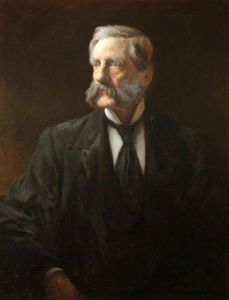Medical doctor and biologist
On 13th December 1817 Hartur Hill Hassal, a doctor, biologist, chemist, microscopist and promoter of tourism in our city, was born in Teddington near London.
The last of five children of Thomas Hassall (1771-1844) surgeon, and Ann Sherrock (c. 1778-1817), he spent his school years in Richmond and completed his university studies in Dublin and London where he graduated in Medicine.
In England he carried out an intense activity for the benefit of public health, in particular against the sophistication of food. In Dublin, in addition to his medical activity, he also studied botany, of which he was very fond, and at the age of 29 in 1846 he published a study in two volumes, "The Microscopic Anatomy of the Human Body in Health and Illness", the first English textbook on the subject.
After further studying botany in Kew and publishing on botanical subjects, in particular freshwater algae, he attracted the public's attention with his book "A microscopic examination of the water supplied to the inhabitants of London and the suburbs", which became an influential work in promoting the cause of water reform. In the early 1850s he also studied food fraud; his reports on Food Adulteration were published in The Lancet magazine and led to legislation against this harmful practice and legislation against food adulteration itself.
His microscopic studies have led him to great discoveries: two medical terms take, universally, the name Hassall: Hassall corpuscles, which are spherical bodies in the thymus marrow, and Hassall-Henle organisms, which have grown abnormally in the Descemet membrane of the eye.
He also worked as a doctor at the Royal Free Hospital, but at that time he was suffering from pulmonary tuberculosis which forced him to frequent interruptions from his work pro and precisely because of his illness in 1869 he moved to the Isle of Wight. On the basis of his experience of the microclimate of the Undercliff, he founded the National Cottage Hospital of Consumption and Chest Diseases (later National Royal Hospital for Chest Diseases). This hospital, recognised as one of the first modern hospitals, operated as a tuberculosis treatment clinic until 1964, when it was demolished to make way for the Ventnor Botanic Garden.
In 1878 he decided to move to Sanremo together with his wife Alice Margaret, with whom he had a son Charles, born in Sanremo in 1881 and unfortunately died at the age of two.
He lived first at Villa Carli and then at Villa Bracco, in Corso Imperatrice, where he also worked as a doctor; among other things, he was Edward Lear's personal physician.
But, in the quiet of Sanremo, he was able to dedicate himself to a complex study of the characteristics of the place, among which the mild climate, the healthy sea air, the good oxygenation and the rich vegetation.
He examined at least a very numerous series of topics that had never before been examined on a scientific level. Among others, he carried out a very accurate bacteriological examination of drinking water, in particular of the three central wells that still supplied the city after the construction of the first Siro Andrea Carli aqueduct.
From his research, two very interesting volumes were published in London, published in English, mainly for a foreign public and not very widespread in Italy, which limited his knowledge of them. The first volume published in 1879 " Sanremo and the Western Riviera climatically and medically considered " and the second one published in 1883 " Sanremo climatically and medically considered ".
These two books trace a true and proper X-ray of Sanremo in those years through a precise and accurate exposition of the naturalistic riches of our land, with constant attention to diseases and hygienic-sanitary problems.
According to the common opinion, these two books have contributed a lot to the influx of English tourists in Sanremo.
Hassal died on 9th April 1894 at the age of 76 and was buried in the cemetery of the Foce, next to the remains of his only son: a slab of white marble unfortunately fractured perpetuates his memory in a foreign land.
Just recently the Rotary Club Sanremo has been carrying out a total restoration of his tomb to keep alive the memory of this illustrious guest of our city.
I believe that Sanremo should not forget this great man and, perhaps, should remember him by naming a beautiful garden after him, since Hassal has always celebrated nature and in particular that of Sanremo and the Riviera di Ponente.
(source: Marco Mauro)





